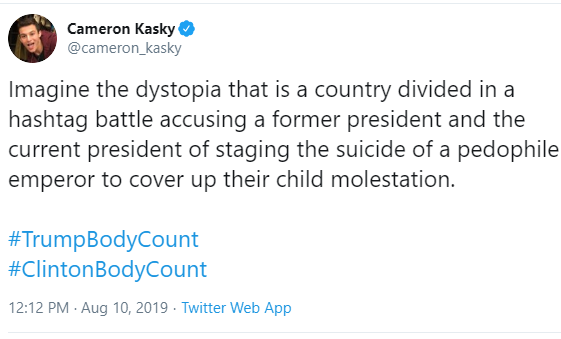


Dark Side of Communications Turns Darker: Epstein, Twitter and Takeaways for Crisis Response
By Thom Fladung/Hennes Communications
Even in this era, when the news barrage can be numbing, the report that Jeffrey Epstein had apparently hanged himself in jail and the immediate flurry of conspiracy theories took a run at qualifying as “shocking.”
The least surprising element: Much of it started and played out on Twitter.
In an insightful opinion column in the New York Times the next day, Charlie Warzel called it “a grim testament to our deeply poisoned information ecosystem – one that’s built for speed and designed to reward the most incendiary impulses of its worst actors.”
Squaring off on Twitter were the opposing hashtags of #ClintonBodyCount and #TrumpBodyCount, each focused on the respective family ties to Epstein, the financier accused of child sex-trafficking.
Hashtag war winners are often impossible to determine. But the losers, again, were clear: reported and corroborated facts and truth.
The day the story broke on Twitter, as the New York Times column noted, propaganda expert Renee DiResta tweeted that the media’s close relationship with Twitter creates an incentive for dueling trolls to use that relationship to their advantage.
Indeed, media members are among Twitter’s most avid and active users. It’s getting dated, but a 2015 survey showed that 25 percent of Twitter verified accounts were journalists. (In the Twitterverse, a verified account is designated by a blue badge with a check mark. Verification is Twitter’s way of saying “this is an account of public interest and we’ve verified that it’s authentic,” i.e., not a fake or parody account.)
But as DiResta noted, journalists’ intense interest in Twitter can result – and did result – in an opposite intended effect. In this case, journalists reported on the controversial hashtags, criticized the spread of more conspiracy theories – and in so doing made them news stories and got them more attention.
“Any wayward tweet…can be elevated to an opinion worth paying attention to,” DiResta wrote. “If you make it trend, you make it true.”
That pungent observation – “if you make it trend, you make it true” – should send a chill through anyone or any organization subject to attack on Twitter.
And it’s one more compelling reason why crisis and reputation management strategies must include social media – indeed, most strategies should start there.
The best defense – on Twitter or anywhere – is, of course, the truth. Tell the truth about yourself and your organization and you’ll have a much better chance of protecting or salvaging your reputation. And you can’t be accused of a cover-up.
A few of the other key elements of successful reputation management on social media include:
- Speed. You must be prepared to tell your story and tell it fast. Twitter and Facebook won’t wait.
- Assessing the threat. Is the main source of the social media posts credible or in a position to know what they’re talking about? Are the critical posts gaining traction, prompting retweets or shares? Are they crossing social media platforms?
- Determining influence. Does your critic have a substantial following across social media?
- Correcting misinformation. Don’t let misstatements of fact live online. Set the record straight – preferably with links to independent corroboration.
As Warzel wrote in assessing the Twitter traffic around Epstein’s death: “Saturday’s online toxicity may have felt novel, but it’s part of a familiar cycle: What cannot be easily explained is answered by convenient untruths.”
Don’t let someone else’s “convenient untruths” about you – on Twitter or anywhere – ruin your reputation.
For more on social media, crisis communications and reputation management, contact Hennes Communications at www.crisiscommunications.com